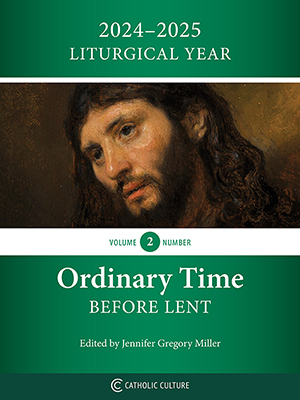Out of the past, three surprise books, all occasions of grace
By Dr. Jeff Mirus ( bio - articles - email ) | Apr 19, 2021 | In Reviews
It is rare that I can comment on newly-published books without reading them for review purposes, but I was surprised to find three new books on my desk this week that I already knew were well-worthwhile. I knew this for different reasons in each case, but with a certainty which makes it impossible for me to go wrong in recommending them to others. My only regret is that I did not call attention to them earlier, as two of the three—though worth reading at any time—were ideal for Lent.
Free eBook:

|
| Free eBook: Liturgical Year 2024-2025, Vol. 2 |
The Sufferings of Christ
For example, during Lent this year I had read an ebook version of Fr. Gerald Vann’s 1947 meditations on The Pain of Christ and the Sorrow of God, but my wife had downloaded it, and ebooks typically skip over title and publisher pages, so I read it through without realizing it was a new edition published this year by Sophia Institute Press. Yet there it was in a stack of books on my desk still awaiting consideration in the third week of Easter. I had already enjoyed and benefited a great deal from Fr. Vann’s reflections. Even the chapter titles are evocative of our relationship to the sufferings of Christ: The Agony in the Garden, The Betrayal, The Scourging, The Stillness of Mary, The Valley of the Shadow of Death, Between Two Thieves, and The Sorrow of God.
The last chapter of Fr. Vann’s inspiring (and highly intelligent) little book gets into the deeper philosophical and theological waters of “suffering” in God. This will go over the heads of most readers who, I believe, will not be nearly as concerned as Fr. Vann seems to expect about how God “experiences” distress in his unfathomable love. But it is an effort to answer the concern that God’s “impassibility” might lead us to call into question the depth of His love. The rest of the book is a superb and enriching series of reflections on our relationship to Christ’s sufferings, ideal for Lent but wonderful reading at any time. My favorite line out of a great many good ones comes from the sixth chapter, “Between Two Thieves”, where Fr. Vann writes: “We are to try to be in the company not of the betrayers but of the betrayed.”
The Shroud of Turin
Looking further through the stack, I was reminded that I had also put in my keeper pile a new study of the Shroud of Turin by the indefatigable Catholic geneticist Gerard Verschuuren, who had already written more than one book I have read and heartily recommended. This one is entitled A Catholic Scientist Champions the Shroud of Turin, also from Sophia. While I am going to read it, I know from past experience that I can call it to the attention of readers without any anxiety at all.
As you would expect from Verschuuren, what you get in this book is an extremely well-organized and well-argued assessment of the authenticity of the Shroud as the burial cloth in which Christ’s body was wrapped before he was laid in the tomb. As readers may know, the Shroud has been extensively studied by scientists, extensively discussed as an artifact throughout history, and even more extensively reflected on in Faith. Verschuuren is in an excellent position to evaluate the competing claims, and does so here, covering the Bible and the history as well as computer analysis and the separate analyses of anatomy, the cloth itself, pollen, carbon, blood and DNA. Links are also provided to fine videos on the Shroud.
Back to Vatican II
Meanwhile, out of the blue had come a review copy of a solid clothbound book of very high quality from The Word on Fire Institute entitled Vatican II Collection. Surprisingly, it is a special value of this collection that it includes only the four most important documents of the Council, with which every well-informed Catholic should have some familiarity. These include the three Dogmatic Constitutions—on Divine Revelation, on the Church, and on the Sacred Liturgy—which will remain necessarily important until Our Lord returns, and the more controversial Pastoral Constitution on the Church in the Modern World.
The latter, being pastoral rather than dogmatic in character, has far less importance to the teachings of the Church going forward. But it does offer many real insights into the Church’s relationship with the world—while at the same time providing additional insight into a certain naivete which led so many of the Council Fathers to regard the 1960s as a propitious “Catholic moment”.
But that too is important to a proper understanding of the Council. And after a space of more than fifty years, it is clear that, apart from particular interests in various special ecclesiastical topics which merited their own briefer documents—and excepting only the immense post-conciliar quarrel (almost completely unnecessary in my opinion) which emerged over the nature of religious liberty—these Constitutions merit the greatest historical and theological attention by Catholics truly committed to authentic renewal today.
Perhaps that is a great deal to push into one paragraph. But in this case my recommendation is based on having read all of the documents of the Council several times myself. This is, after all, a new edition, with commentary by both later popes and various curial congregations under their direction, and by Bishop Robert Barron, who rightly insists that the post-conciliar debates have extended now for decades largely in ignorance of the actual texts. The better to mark your place, this edition even comes with a ribbon. (By the way, my own introductions to and summaries of all sixteen Conciliar documents, in order of approval, are available as one of our free ebooks: The Documents of Vatican II: A Summary and Guide.)
In any case, please don’t pipe up about Vatican II without a prayerful reading of at least the three Dogmatic Constitutions.
Betrayal
Of course, reading any or all of these books will be far too little to alter the course of history, or the progressive slide into ever-increasing infidelity on the part of the once-Christian West. For that a far-deeper conversion is needed than can come from reading alone—but also a far more widespread conversion, in God’s own time, inspired and nourished now by the few who lead the way.
What I can do here is warn you that all three of these books are capable of challenging our fallen nature. Perhaps that is because we really are to be among the betrayed rather than the betrayers, and these texts provide significant occasions of exactly that sort of grace.
Gerald Vann, OP: The Pain of Christ and the Sorrow of God. Sophia Institute Press, 2021. Paper, 112 pp., $14.95. (Also available as an ebook on Amazon for Kindle.)
Gerard Verschuuren: A Catholic Scientist Champions the Shroud of Turin. Sophia Institute Press, 2021. Paper, 192 pp., $17.95.
Vatican II Collection. Word on Fire Institute, 2021. Cloth, 392 pp., launch price $23.96.
All comments are moderated. To lighten our editing burden, only current donors are allowed to Sound Off. If you are a current donor, log in to see the comment form; otherwise please support our work, and Sound Off!







